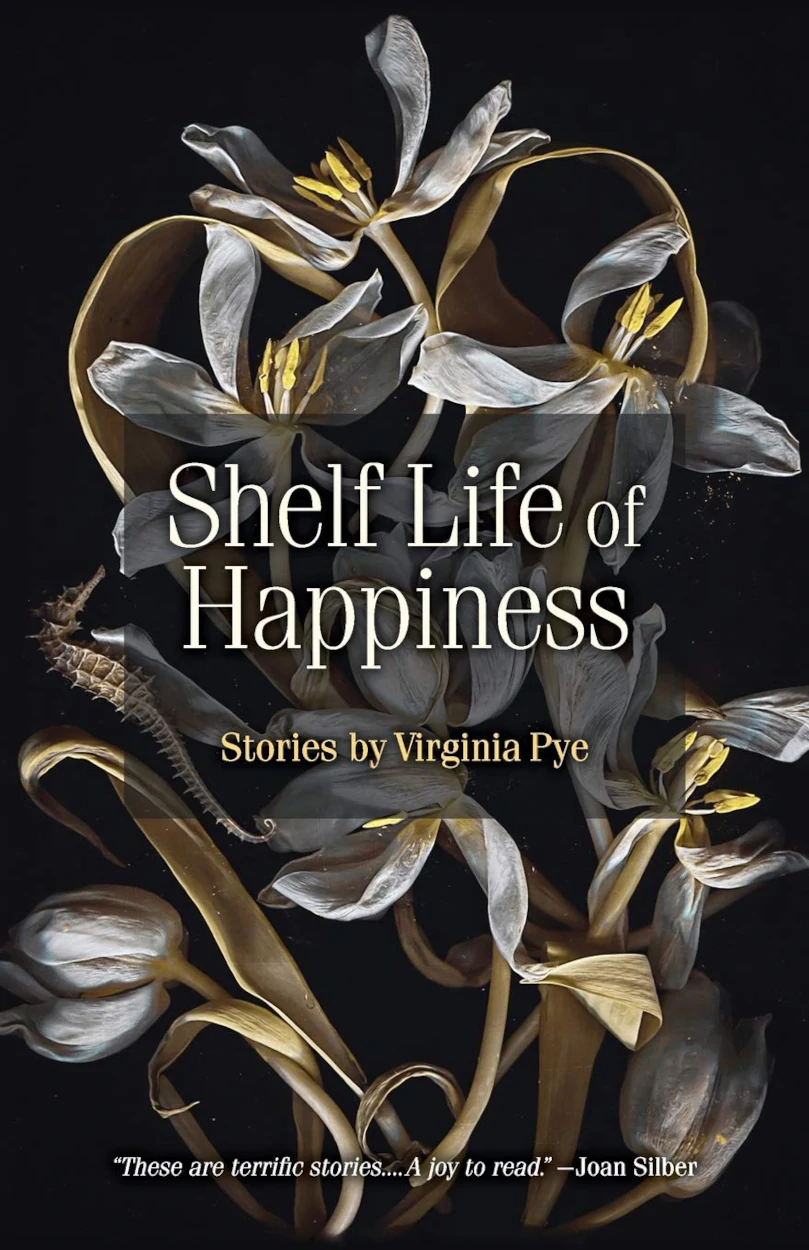
Half and Half: A Review of Virginia Pye’s Shelf Life of Happiness
Words By Jordan Ryder
Virginia Pye wrote two award-winning works before her newest release Shelf Life of Happiness. When I heard about it, I was really, genuinely excited. Happiness does exist on a shelf, doesn’t it? It expires, sometimes going unnoticed until you twist open the top and find your jam has gone green and hairy while you were in the other room. My interest was piqued. I was intrigued. But oh, it’s a bag of mixed feelings, this one.
In Shelf Life of Happiness, Virginia Pye explores the fragility and elusiveness of, well, being happy. Adults have a hard time with happiness, she suggests. In “Crying in Italian,” Sara’s marriage has lost its fervor. She and her spouse have become two people with kids, and Sara is leaving for more passionate pastures. In “Redbone,” Tom discovers he was happier before, though he hadn’t known it at the time. It’s that “we didn’t know how good we had it” concept. For Tom, the greener grass was his life before he was successful. Before he’d decided to leave his wife. When he could still go home and hang out with his girls.
Kids are better off, however, as Pye shows us. Kids understand something about happiness that the rest of us don’t. In “Easter Morning,” a nameless boy tries to take care of a dead bird. And there’s something about caring for things, about something living on after death, that a group of mothers want to preserve in this child. To care despite death, to treat something as a living thing after it is no longer, is something important—and this kid knows it. In “An Awesome Gap,” Patrick, a fifteen-year-old skateboarder, wants to show his dad how to “live in the now.” He’d never become “a slave to work” the way his father is. He’s going to live in “real places” with “real people.”
But this brings me to my first point—what are real people and real places? Not a clue because, unfortunately, Pye writes in generalities. In “White Dog,” we get: “Like Dunster himself, [his granddaughter] had been to hell and back.” We understand Dunster was in the war, which must be what Pye is referring to here as “hell.” (What sort of hell, what it looked like and felt like for Dunster, we will never know.) What his granddaughter’s hell was, however, is a true mystery. There are no clues, hints, or even assurances that Pye knows herself.
In “Easter Morning,” there’s the line, “In one brief moment, her son has become fully-grown and capable of deception, as well as sacrifice and love.” But how does one deception prove a person’s maturity, or their ability to love and to sacrifice? Can someone really grow up in the space of a moment? Maybe. But I think you’d have to give a pretty good case for it.
What’s perhaps more problematic in this book, and even unsettling, is the now too-traditional, outdated, and awkwardly misogynistic themes so present in the stories—everything from one character’s ambitions being “manly” to the wives being referred to as “the women” and the husbands “the men” in “Easter Morning” (because it’s always best to define a group of people by their gender).
Every time a character in Shelf Life of Happiness is extraordinarily successful in their field—be it art, literature, art distribution—it’s a man. And not only that, but these men are big names in their businesses. Comparatively, the few women who do have jobs are librarians or teachers (caregivers, in one role or another) despite Cambridge educations, as in “Her Mother’s Garden.” The sole exception to this rule is Gloria, who works in publishing. When speaking with her male writer friend, who is a Big Name in his Business, she says that ambition is a “big” and “manly” quality. Gloria works behind a desk making her reputation by making sure her male friend’s work gets printed big (that is, actually, a line from the book). He suggests—out of doe-eyed love it seems, for it’s unclear he cares to read anything of hers—that she must be a great writer after her father. Gloria refutes him. “Oh no,” she says, “that’s you.”
I would have liked—would have needed, actually—one woman to take charge of her future. I needed Annie from “Her Mother’s Garden” to break up with Fred when she realized she was just “his interest.” Or when he said that with her mothers’ “cataracts, she probably [couldn’t] see past the whatever-you-call those” flowers: the moment Annie realized she hated him. I would have needed “one of [those] mothers” to have a moment with the boy who had kept the dead bird, to tell him what he’d done was right, whatever his father said. I needed Gloria to submit her own work, or to decide somehow what she wanted professionally, besides what was in Nathan’s best interest.
I would have needed these things because those are the women I like reading about, who I can relate to. Who inspire me. And even though all the female characters don’t have to be wonderful and brave and courageous, some of them do. Because lots of us are.
Pye tackles so many characters and settings in this book. We go from the young skater to the old artist Dunster, and the in-between, like writer Nathan—everywhere from Italian ruins to skating parks. Pye plays around in these settings and with these characters, giving us so many different spaces to inhabit. It’s a dizzying cast.
It’s just that Shelf Life of Happiness reads like a glass half-full of whiskey, half-full of water. The collection lacked tangible, graspable descriptions, and clear, pointed insight. The more general you get, the more water you add. I like my stories neat, so to speak. But it is so much about taste with these things, and perhaps half-and-half is just your cup of whiskey. If so, have at it.